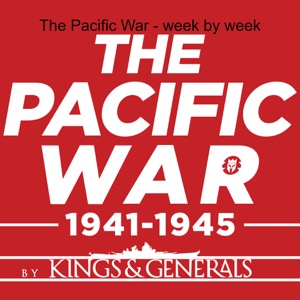- 171 - Pacific War Podcast - The Fall of Manila - February 25 - March 4 - , 1945
The Pacific War - week by week - A podcast by kingsandgenerals - Tuesdays

Last time we spoke about the invasion of iwo jima. General LeMay's B-29 bombers targeted Japan, inflicting heavy damage on Kobe and Ota's Nakajima factory, though at a cost of lost aircraft. Meanwhile, U.S. forces prepared for the Iwo Jima assault. On February 19, Marines landed amid intense bombardment, facing fierce Japanese resistance. Progress was slow, with heavy casualties. By February 21, they fought to capture Mount Suribachi. Amidst the chaos, kamikaze attacks struck American carriers, causing significant losses and foreshadowing the brutal battles ahead. In the midst of a relentless rain on February 22, Colonel Liversedge led the 28th Marines in a fierce assault on Mount Suribachi, facing determined Japanese resistance. Despite harsh conditions and significant casualties, the Marines pushed forward. On February 23, they reached the summit, raising the American flag to symbolize their hard-fought victory. The Secretary of the Navy, inspired by the moment, declared it would ensure the Marine Corps' legacy for centuries. As battles continued, the Marines faced heavy losses but remained resolute in their mission. This episode is the fall of Manila Welcome to the Pacific War Podcast Week by Week, I am your dutiful host Craig Watson. But, before we start I want to also remind you this podcast is only made possible through the efforts of Kings and Generals over at Youtube. Perhaps you want to learn more about world war two? Kings and Generals have an assortment of episodes on world war two and much more so go give them a look over on Youtube. So please subscribe to Kings and Generals over at Youtube and to continue helping us produce this content please check out www.patreon.com/kingsandgenerals. If you are still hungry for some more history related content, over on my channel, the Pacific War Channel you can find a few videos all the way from the Opium Wars of the 1800’s until the end of the Pacific War in 1945. As we last observed in Manila, General Griswold's forces had effectively confined the remnants of Admiral Iwabuchi's troops to Intramuros, the South Port Area, and the Philippine Commonwealth Government buildings located at the southeastern edge of the Walled City. Available information led to the conclusion that the Japanese defenses were strongest on the southern and eastern sides of the Walled City and that the Japanese expected attack from these, the most logical directions. Japanese garrisons in the Legislative, Finance, and Agriculture Buildings just across Padre Burgos Street southeast of Intramuros could cover these approaches. The 37th Division could, of course, take the government buildings before launching an assault on Intramuros, but it would be easier to attack the government buildings after Intramuros fell. Conversely, planners deemed it feasible to strike into Intramuros from the west, since Japanese defenses along the west wall, across Bonifacio Street from the Manila Hotel and the South Port Area, appeared weak. But in this case, American troops would first have to clear the South Port Area and then, advancing from the west, would have to attack toward much of their own supporting artillery. The artillery's best positions for close support were on the north and northeast, across the Pasig, and on the east, in the area south from the General Post Office to the City Hall, and much of the artillery ultimately did fire from these areas. About halfway from the northeast to the northwest corner of Intramuros the ancient wall ended, providing direct access into the Walled City at the Government Mint. The only other obstacle on the north was a low sea wall running along the south bank of the Pasig, and Japanese defenses along the north face appeared weak except at the northeast corner. Planners therefore decided that there would be an excellent chance to execute a successful amphibious assault from the north bank of the Pasig against the north-central side of the Walled City. Given that the
